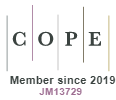Submissions
Submission Preparation Checklist
As part of the submission process, authors are required to check off their submission's compliance with all of the following items, and submissions may be returned to authors that do not adhere to these guidelines.- The submission has not been published previously. Also, it shouldn't be in another journal for consideration or in any other editorial process.
- The submission file is in Microsoft Word document file format.
- Where ever required, DOI's and URLs for the references have been provided, accurately.
- The text adheres to the stylistic and bibliographic requirements outlined in the Author Guidelines.
- I confirm that all the data collected from this theoretical and/or experimental study is presented only in the manuscript, and will not be published partially or fully separately, elsewhere.
- I confirm to provide the collected data on which this manuscript is based, if required for examinations by the editor.
Copyright Notice
Authors of published articles remain the copyright holders and grant third parties the right to use, reproduce, and share the article as per the CC BY Attribution 4.0 license agreement. This copyright and license information remains available at the end of the published research article.
Articles in the Journal of Creative Space (Creat. Sp.) are Platinum Open Access articles that are published with licenses under a Creative Commons Attribution- CC-BY 4.0 International License. Based on a work at https://cs.chitkara.edu.in. This license permits one to use, remix, tweak and reproduce in any medium, even commercially provided one gives credit for the original creation.
View Legal Code of the above-mentioned license, https://creativecommons.org/licenses/by/4.0/legalcode
View Licence Deed here https://creativecommons.org/licenses/by/4.0/
 |
Journal of Creative Space by Chitkara University Publications is licensed under a Creative Commons Attribution 4.0 International License. Based on a work at https://cs.chitkara.edu.in/ |
Privacy Statement
The names and email addresses entered in this journal site will be used exclusively for the stated purposes of this journal and will not be made available for any other purpose or to any other party.







